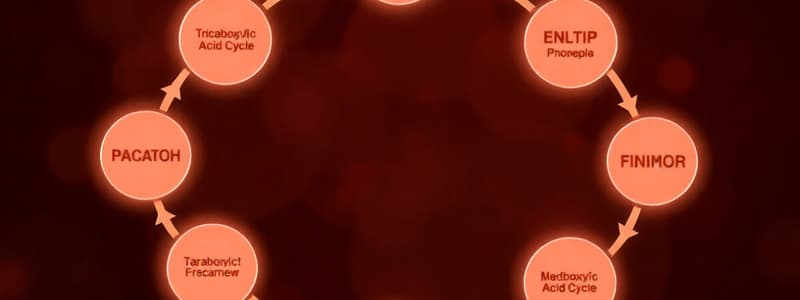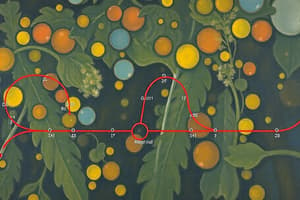Podcast
Questions and Answers
What is one of the major roles of acetyl-CoA in the tricarboxylic acid cycle (TCA)?
What is one of the major roles of acetyl-CoA in the tricarboxylic acid cycle (TCA)?
What happens to pyruvate when it undergoes carboxylation?
What happens to pyruvate when it undergoes carboxylation?
Which metabolic condition can arise from defects in pyruvate dehydrogenase?
Which metabolic condition can arise from defects in pyruvate dehydrogenase?
What is the consequence of a deficiency in pyruvate carboxylase?
What is the consequence of a deficiency in pyruvate carboxylase?
Signup and view all the answers
In which tissue is oxidative decarboxylation of pyruvate particularly important?
In which tissue is oxidative decarboxylation of pyruvate particularly important?
Signup and view all the answers
Which statement accurately describes the tricarboxylic acid cycle (TAC)?
Which statement accurately describes the tricarboxylic acid cycle (TAC)?
Signup and view all the answers
What is the total energy yield from the oxidation of one molecule of acetyl CoA in the TCA cycle?
What is the total energy yield from the oxidation of one molecule of acetyl CoA in the TCA cycle?
Signup and view all the answers
Which enzyme is NOT primarily involved in the regulation of the TCA cycle?
Which enzyme is NOT primarily involved in the regulation of the TCA cycle?
Signup and view all the answers
Why can fatty acids not contribute to gluconeogenesis in humans?
Why can fatty acids not contribute to gluconeogenesis in humans?
Signup and view all the answers
Which of the following statements about the citric acid cycle is correct?
Which of the following statements about the citric acid cycle is correct?
Signup and view all the answers
Study Notes
Lecture 20: Tricarboxylic Acid Cycle (TAC)
- The lecture covers the Tricarboxylic Acid Cycle (TAC), also known as the Citric Acid Cycle or Krebs Cycle.
- Specific learning objectives include discussing pyruvate's alternate fates, understanding the cycle's role in nutrient metabolism, and identifying energy molecules released during the cycle.
Integration of Major Metabolic Pathways
- Carbohydrates are broken down through glycolysis to pyruvate, then to Acetyl CoA, which enters the citric acid cycle.
- Fatty acids undergo beta-oxidation and are converted to Acetyl CoA, entering the cycle.
- Amino acids, after transamination, can enter the cycle at different points.
Overview of TAC
- The TCA cycle is a crucial part of metabolism, occurring entirely within the mitochondria.
- It's an amphibolic pathway, meaning it's involved in both catabolism (breaking down molecules) and anabolism (building molecules).
- It's the final pathway for carbohydrate, amino acid, and fatty acid oxidation; these carbon skeletons are broken down to CO2.
Alternate Fates of Pyruvate
- Oxidative decarboxylation: An important pathway in tissues with high oxidative capacity (e.g., cardiac muscle).
- Acetyl CoA is a major fuel for the TCA cycle and a building block for fatty acid synthesis.
Carboxylation of Pyruvate to Oxaloacetate
- This reaction replenishes TCA cycle intermediates and provides a substrate for gluconeogenesis.
Metabolic Defects of Oxidative Metabolism
- Defects in pyruvate dehydrogenase or pyruvate carboxylase can lead to conditions like lactic acidosis and neurological disorders.
Energy Production by the TCA Cycle
- The total energy yield from TCA cycle oxidation of one Acetyl CoA molecule is 12 ATP.
Regulation of the TCA Cycle
- The TCA cycle is regulated by controlling enzyme activity.
- Key enzymes include citrate synthase, isocitrate dehydrogenase, and the α-ketoglutarate dehydrogenase complex.
Excess Carbohydrates and Fat Conversion
- Excess carbohydrates are stored as neutral fat in adipose tissue.
- The pathway involves glucose to pyruvate to Acetyl CoA to fatty acids, binding to glycerol to form triacylglycerol.
No Net Synthesis of Carbohydrates from Fatty Acids
- Fatty acids are broken down to Acetyl CoA and completely oxidized to CO2 within the cycle.
- Acetyl CoA cannot be used for gluconeogenesis.
- Therefore, there's no net synthesis of carbohydrates from fatty acids.
Influx of TCA Cycle Intermediates
- Various molecules (glucose, amino acids, etc.) can enter the cycle via different intermediates.
Efflux of TCA Cycle Intermediates
- Molecules like Acetyl CoA, Oxaloacetate, and Citrate can leave the cycle to be used in other pathways (e.g., fatty acid synthesis, gluconeogenesis).
Studying That Suits You
Use AI to generate personalized quizzes and flashcards to suit your learning preferences.
Related Documents
Description
This quiz explores the Tricarboxylic Acid Cycle (TAC), also known as the Citric Acid Cycle or Krebs Cycle. It covers the metabolic pathways involving carbohydrates, fatty acids, and amino acids and their roles in energy production. Test your understanding of the cycle's integration in nutrient metabolism and energy molecule release.




